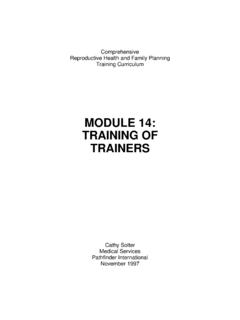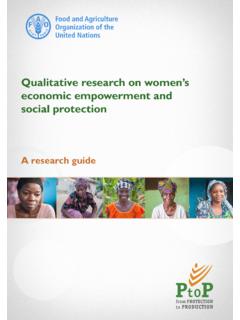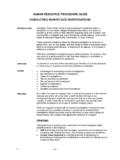Transcription of CONDUCTING IN-DEPTH INTERVIEWS: A Guide for …
1 PATHFINDERINTERNATIONALTOOLSERIESM onitoring and Evaluation 2 CONDUCTING IN-DEPTHINTERVIEWS: A Guide for Designing andConducting IN-DEPTH Interviewsfor Evaluation InputByCarolyn Boyce, MA, Evaluation AssociatePalena Neale, PhD, Senior Evaluation AssociateMay 2006 PATHFINDERINTERNATIONALTOOLSERIESM onitoring and Evaluation 2 CONDUCTING IN-DEPTHINTERVIEWS: A Guide for Designing andConducting IN-DEPTH Interviewsfor Evaluation InputByCarolyn Boyce, MA, Evaluation AssociatePalena Neale, PhD, Senior Evaluation AssociateMay 2006 AcknowledgementsThe authors would like to thank the following Pathfinder employees and partners for theirtechnical inputs into this document: Anne Palmer (Futures Group International), UgoDaniels (African Youth Alliance (AYA)), Veronique Dupont (Pathfinder/Extending ServiceDelivery (ESD)), Cathy Solter, Lauren Dunnington, and Shannon Pryor (Pathfinderheadquarters). Jenny Wilder and Mary Burket are also thanked for their inputs andassistance in editing and producing this : CONDUCTINGIN-DEPTHINTERVIEWSWhat is an IN-DEPTH interview ?
2 IN-DEPTH interviewing is a qualitative research technique that involves CONDUCTING intensiveindividual interviews with a small number of respondents to explore their perspectives on aparticular idea, program, or situation. For example, we might ask participants, staff, and othersassociated with a program about their experiences and expectations related to the program, thethoughts they have concerning program operations, processes, and outcomes, and about anychanges they perceive in themselves as a result of their involvement in the are IN-DEPTH Interviews Appropriate? IN-DEPTH interviews are useful when you want detailed information about a person sthoughts and behaviors or want to explore new issues in depth . Interviews are often usedto provide context to other data (such as outcome data), offering a more complete pictureof what happened in the program and why. For example, you may have measured anincrease in youth visits to a clinic, and through IN-DEPTH interviews you find out that ayouth noted that she went to the clinic because she saw a new sign outside of the clinicadvertising youth hours.
3 You might also interview a clinic staff member to find out theirperspective on the clinic s youth friendliness. IN-DEPTH interviews should be used in place of focus groups if the potential participantsmay not be included or comfortable talking openly in a group, or when you want todistinguish individual (as opposed to group) opinions about the program. They are oftenused to refine questions for future surveys of a particular are the Advantages and Limitations of IN-DEPTH Interviews?The primary advantage of IN-DEPTH interviews is that they provide much more detailedinformation than what is available through other data collection methods, such as also may provide a more relaxed atmosphere in which to collect information people may feel more comfortable having a conversation with you about their program asopposed to filling out a survey. However, there are a few limitations and pitfalls, each ofwhich is described to bias:Because program or clinic staff might want to prove that a program isworking, their interview responses might be biased.
4 Responses from community membersand program participants could also be biased due to their stake in the program or for anumber of other reasons. Every effort should be made to design a data collection effort,create instruments, and conduct interviews to allow for minimal bias. Can be time-intensive:Interviews can be a time-intensive evaluation activity because of thetime it takes to conduct interviews, transcribe them, and analyze the results. In planningPATHFINDERINTERNATIONAL: CONDUCTINGIN-DEPTHINTERVIEWS3your data collection effort, care must be taken to include time for transcription andanalysis of this detailed must be appropriately trained in interviewing techniques:To provide the mostdetailed and rich data from an interviewee, the interviewer must make that personcomfortable and appear interested in what they are saying. They must also be sure to useeffective interview techniques, such as avoiding yes/no and leading questions, usingappropriate body language, and keeping their personal opinions in generalizable:When IN-DEPTH interviews are conducted, generalizations about the resultsare usually not able to be made because small samples are chosen and random samplingmethods are not used.
5 IN-DEPTH interviews however, provide valuable information forprograms, particularly when supplementing other methods of data collection. It should benoted that the general rule on sample size for interviews is that when the same stories,themes, issues, and topics are emerging from the interviewees, then a sufficient sample sizehas been is the Process for CONDUCTING IN-DEPTH Interviews?The process for CONDUCTING IN-DEPTH interviews follows the same general process as isfollowed for other research: plan, develop instruments, collect data, analyze data, anddisseminate findings. More detailed steps are given Plan Identify stakeholders who will be involved. Identify what information is needed and from whom. (See What are PotentialSources of Information? ) List stakeholders to be interviewed. Identify stakeholder groups from national, facility,and beneficiary levels and then identify individuals within those groups additionalinterviewees may be identified during data collection.
6 Determine sample if necessary. Ensure research will follow international and national ethical research standards,including review by ethical research committees. For more information, please see theInternational Ethical Guidelines for Biomedical Research Involving Human Subjects,available at : CONDUCTINGIN-DEPTHINTERVIEWS2. Develop Instruments Develop an interview protocol the rules that Guide the administration andimplementation of the interviews. Put simply, these are the instructions that arefollowed for each interview , to ensure consistency between interviews, and thusincrease the reliability of the findings. The following instructions for the interviewershould be included in the protocol: What to say to interviewees when setting up the interview ; What to say to interviewees when beginning the interview , including ensuringinformed consent and confidentiality of the interviewee (see Appendix 1 for an example); What to say to interviewees in concluding the interview ; What to do during the interview (Example: Take notes?)
7 Audiotape? Both?); and What to do following the interview (Example: Fill in notes? Check audiotapefor clarity? Summarize key information for each? Submit written findings?). Develop an interview Guide that lists the questions or issues to be explored during theinterview and includes an informed consent form. There should be no more than 15main questions to Guide the interview , and probes should be included where helpful (see interview Question Tips ). An example is provided in Appendix 1. Please note that youwill likely need interview guides for each group of stakeholders, as questions may differ. Where necessary, translate guides into local languages and test the QuestionTips Questions should be open-ended rather than closed-ended. For example, insteadof asking Do you know about the clinic s services? ask Please describe theclinic s services. You should ask factual question before opinion questions. For example, ask, Whatactivities were conducted?
8 Before asking, What did you think of the activities? Use probes as needed. These include: Would you give me an example? Can you elaborate on that idea? Would you explain that further? I m not sure I understand what you re saying. Is there anything else?PATHFINDERINTERNATIONAL: CONDUCTINGIN-DEPTHINTERVIEWS53. Train Data Collectors Identify and train interviewers (see Training Tips for Data Collectors 1). Wherenecessary, use interviewers that speak the local Collect Data Set up interviews with stakeholders (be sure to explain the purpose of the interview ,why the stakeholder has been chosen, and the expected duration of the interview ). Seek informed consent of the interviewee (written or documented oral). Re-explainthe purpose of the interview , why the stakeholder has been chosen, expected durationof the interview , whether and how the information will be kept confidential, and theuse of a note taker and/or tape recorder.
9 If interviewee has consented, conduct the interview . Summarize key data immediately following the interview . Verify information given in interviews as necessary. For example, if an intervieweesays that a clinic has a policy of not providing services to anyone under 16, youshould verify that information on your own with the Tips for Data CollectorsStaff, youth program participants, or professional interviewers may be involved in datacollection. Regardless of what experience data collectors have, training should include: An introduction to the evaluation objectives, A review of data collection techniques, A thorough review of the data collction items and instruments, Practice in the use of the instruments, Skill-building exercises on interviewing and interpersonal communication, and Discussion of ethical : CONDUCTINGIN-DEPTHINTERVIEWS1 Adamchak, S. (2000). A Guide To Monitoring and Evaluating Adolescent Reproductive Health Analyze Data Transcribe and/or review data.
10 Analyze all interview data (see Tips on Analyzing interview Responses 2).6. Disseminate Findings Write report (see How are IN-DEPTH Interviews Presented? ). Solicit feedback from interviewees and program stakeholders. Revise. Disseminate to interviewees, program stakeholders, funders, and the community asappropriate. What are Potential Sources of Information? IN-DEPTH interviews typically rely on multiple sources of information to provide ascomplete a picture as possible. Information sources could include: Policy Makers Program Participants/Clients Project Staff Community Members Clinic StaffWhen choosing interviewees, one should consider a sample that best represents the diversestakeholders and opinions of those stakeholders. The general rule about interviewing is thatyou will know when you have done enough when you hear the same information from anumber of on Analyzing interview Responses Read through the interview responses and look for patterns or themes amongthe partcipants.











